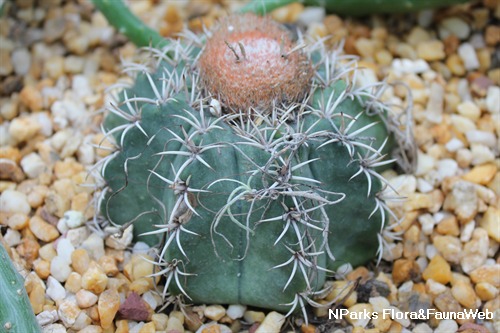
Back
Melocactus pruinosus Werderm.
| Family Name: | Cactaceae |
| Synonyms: | Melocactus concinnus |
| Common Name: | Turk's Cap Cactus, Melon Cactus |
Name
Classifications and Characteristics
| Plant Division | Angiosperms (Flowering Seed Plants) (Dicotyledon) |
|---|---|
| Plant Growth Form | Shrub |
| Lifespan (in Singapore) | Perennial |
| Mode of Nutrition | Autotrophic |
| Plant Shape | Rounded |
| Maximum Height | 8 cm to 9 cm |
| Maximum Plant Spread / Crown Width | 10 cm to 11 cm |
Biogeography
| Native Distribution | Brazil |
|---|---|
| Native Habitat | Terrestrial (Desert / Semi-Desert) |
| Preferred Climate Zone | Desert / Arid |
| Local Conservation Status | Non-native |
| CITES Protection | True |
Description and Ethnobotany
| Growth Form | This species has a round growth form up to 5-6 cm tall. Sexually mature individuals have a cap-like structure on top known as a cephalium (2.5 cm tall). |
|---|---|
| Stems | Bluish stem is composed of thick ribs which are triangular in cross-section and densely lined with thick, curved spines. Each areole produces about 7-8 white spines with reddish brown tips. |
| Flowers | Flowers and fruits are produced from the cephalium, a red, cap-like structure found on top of sexually mature individuals. The cephalium lacks spines and is composed of a dense mass of white wool and red bristles. It is produced by individuals at least 5 years of age or 8 cm wide. Small, bright purple flowers (< 1 cm wide) are star-shaped. |
| Fruit | Bright purple, fleshy fruits are rod-shaped and emerge erect from the white wool of the cephalium. They are produced after the flowers wither in the following year. |
| Habitat | This species occurs on sandy, rocky soils at an altitude of about 1,000 m. It grows on hillsides, often below dwarf trees and shrubs. |
| Cultivation | This species should be grown in a shallow, wide pot with a very porous potting mix to avoid root rot. It prefers moderate shade in a location protected from the wind. When plants are actively growing, they should be watered regularly. |
| Etymology | The species epithet 'concinnus' means graceful. |
Plant Care and Propagation
| Light Preference | Semi-Shade |
|---|---|
| Water Preference | Little Water |
| Maintenance Requirements | High |
| Propagation Method | Seed |
Floral (Angiosperm)
| Flower & Plant Sexuality | Bisexual Flowers |
| Flower Colour(s) | Purple |
|---|---|
| Flower Grouping | Solitary |
| Flower Symmetry | Radial |
Fruit, Seed and Spore
| Mature Fruit Colour(s) | Purple |
|---|---|
| Mature Fruit Texture(s) | Smooth |
| Fruit Classification | Simple Fruit |
| Fruit Type |
References
| References | Slaba, R.. 1992. The Illustrated Guide to Cacti. USA: Sterling Publishing Co., Inc.. 224 |
|---|
Image Repository
Others
| Master ID | 31844 |
|---|---|
| Species ID | 6244 |
| Flora Disclaimer | The information in this website has been compiled from reliable sources, such as reference works on medicinal plants. It is not a substitute for medical advice or treatment and NParks does not purport to provide any medical advice. Readers should always consult his/her physician before using or consuming a plant for medicinal purposes. |
